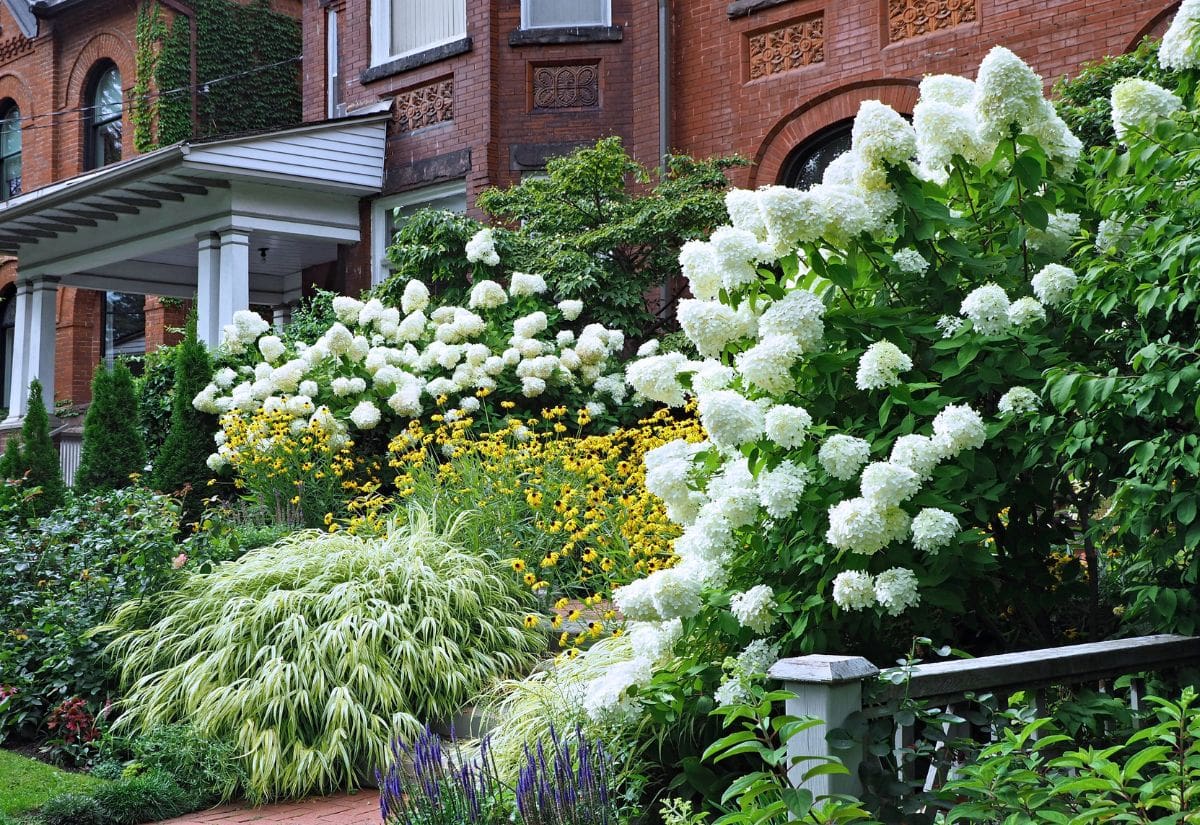
Hydrangeas, with their abundant, leafy foliage and expansive, multicolored blooms, are splendid in their singularity. These flowers, displaying a color spectrum from blue, white, and pink to red and even purple, create a vivid tapestry. Still, they do appreciate a good companion!
If your objective is to seamlessly incorporate this flowering shrub into your garden, achieving that naturalistic design and atmosphere that’s in high demand in landscaping and gardening, and presenting the effect of them always being part of your landscape, selecting the appropriate companion plants for hydrangeas is essential.
While hydrangeas make a great companion with many ornamental plants. But, it’s also worth noting that that all plants aren’t the best friends with hydrangeas.
So, when it’s time to decide what to plant with hydrangeas, the choice requires careful consideration. Your aim is to sync the growing conditions, size, and character, while also introducing a dash of diversity… That’s your recipe for discovering their perfect botanical partner that can thrive next to your hydrangeas as companions.
Shady, temperate in appearance yet highly decorative and vibrant, there’s a wide array of other shrubs, dwarf trees, perennials flowers, ferns, and ornamental grasses you could grow alongside your hydrangeas as partners – and we’ve discovered the cream of the crop!
To get started, we hand-picked some of the best companion plants that promise to not just survive but thrive alongside your hydrangeas.
But first let’s learn how you can choose a good companion plant for your hydrangea shrubs…
How to Choose the Perfect Companion Plants for Hydrangeas
You can go safe and pick one of the plant varieties in our selection for your hydrangea. But it is also good to know why some plants will grow well with this flowering shrub, and why others do not match. And there are a few reasons, which we are going to explore right now!
Choose a Plant That Loves Hydrangea’s Growing Conditions
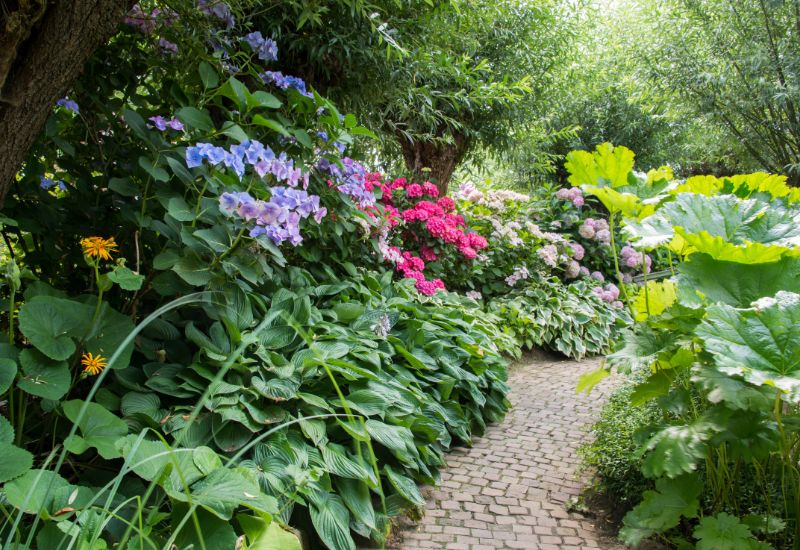
Hydrangeas are easy to grow and fairly adaptable, but they require some specific growing conditions. The companion plants you choose for your hydrangeas should fall within the same.
But there are other reasons why not all plants are good companions for hydrangeas…
Choose Plants that Look Amazing with Your Hydrangea
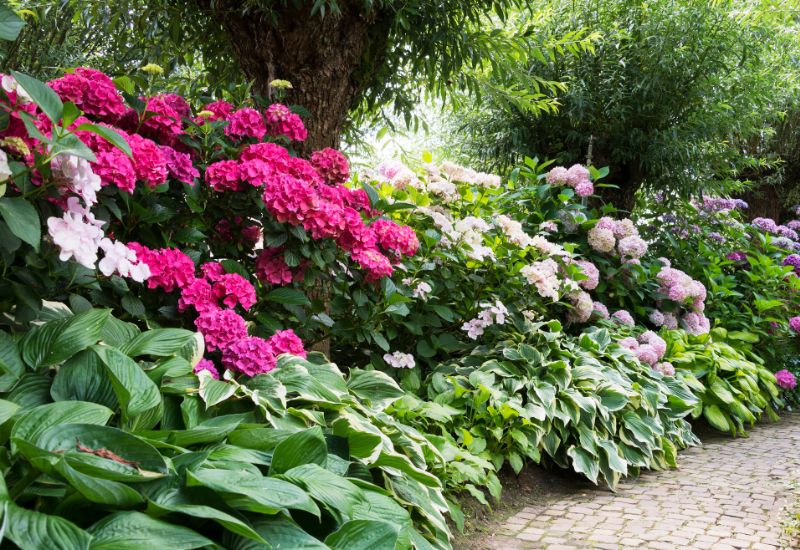
Hydrangeas have their own personality and aesthetics, and you need to be respectful of these with their companion plants. A harsh looking, desert type plant, like a cactus, next to our soft and fresh looking shrub may be experimentally interesting, but is it pleasing? Let’s see what is and what isn’t…
So, these tips will give you some freedom in your choice, so you can experiment a bit in your garden. But let us now see the very best companion plants for your hydrangeas.
15 Great Companion Plants That Look and Grow Well With Hydrangea
If you are curious to know which companion plants for hydrangea made the final cut, here they are in useful categories!
5 Shrubs That Love to Coexist with Hydrangeas
Unless you want to have your hydrangea as a specimen, you may wish to mix it with other shrubs. This way, you can create an ensemble and also have continuity in the blooming season. So, let’s see which shrubs will grow well next to our protagonist.
1. Camellia (Camellia spp.)
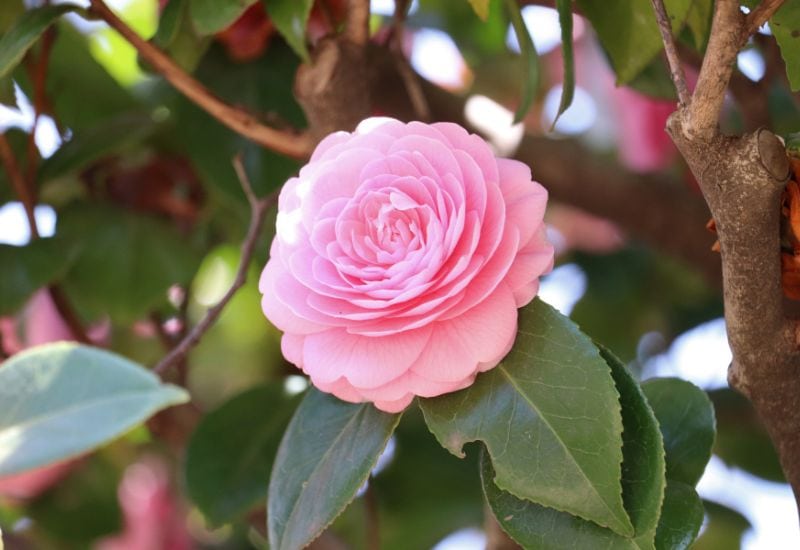
Another shrubby queen of gardens, camellia will make a good companion plant for hydrangeas because you get a continuity of blooms. They will literally pick it up when your hydrangea stops blossoming, and keep going through winter and then spring, till our protagonist starts again.
They also love similar growing conditions and they offer you a range of blooms in shades of white, rose, pink and red! And there are single and double varieties, some with very regular petals, more sculptural, others with ruffled blossoms, more suitable for a traditional looking garden…
And they range from 1 inch to 6.5 inches across (2.5 to 17 cm)! Their glossy, deep green and evergreen leaves also offer you structure all year round and a variation with the foliage of hydrangea.
Camellias, however, are not low maintenance shrubs; if you choose one as a companion plant for your hydrangea, do keep this in mind, and remember that it manages in neutral soil, but it really prefers it acidic, so, if you can bring it to mildly acidic, you will make them both happy!
2. ‘Red Head’ Japanese Andromeda (Pieris japonica ‘Red Head’)
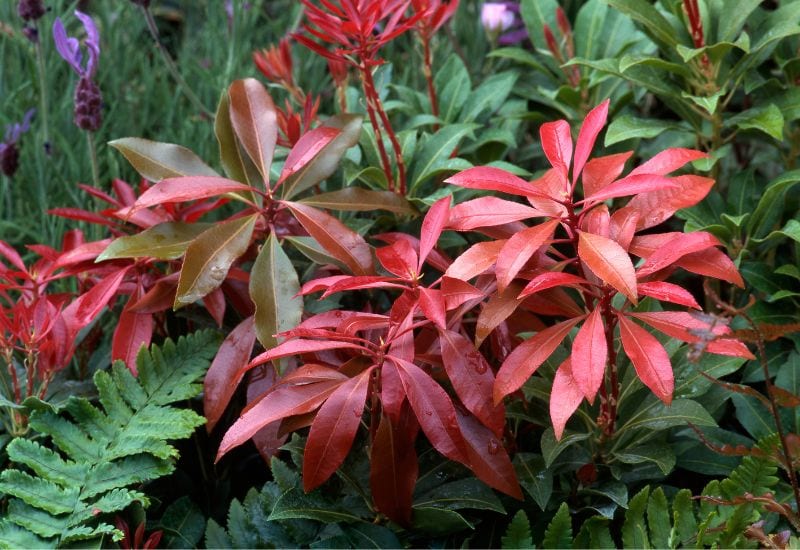
You could also choose other varieties of Pieris Japonica, but ‘Red Head’ Japanese Andromeda will give you the best effect next to hydrangeas. In fact, this shrub perfectly suits its size (others are bigger) and it has a special characteristic that you may like: new leaves are bright red, and then they turn deep and glossy green. Palmate and elegant, they will give you a constant contrast between these two colors. It too has a round habit, and it will literally change again in spring…
This is due to its massive floral display though. Long and hanging clusters of bright nodding and urn shaped flowers will hang beautifully from its branches, very dense and striking indeed. Some specimen may also offer you blushes of rise and pink in their blossoms.
Just move a bit close and you will also be amazed by their sweet fragrance, as will pollinators. And the blossoms seem to be coordinated: as soon as ‘Red Head’ stops, your hydrangea will start, so there’s no stealing the show!
Providing structure and color all year round, ‘Red Head’ Japanese Andromeda will definitely help out the landscaping effect of your hydrangeas, helping out when she goes dormant, and giving you a lovely contrast when she is vegetative.
3. Azalea and Rhododendron (Rhododendron spp.)
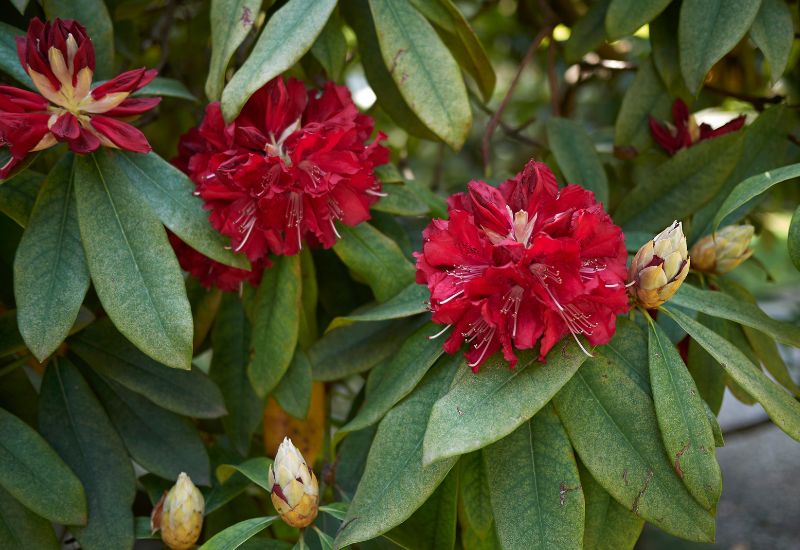
Azaleas and rhododendrons (they are the same genus) are often cited as good companion shrubs for hydrangeas. However, this is true only of your soil is mildly acidic, as they will survive with neutral pH, but they won’t perform well. Having said this, they will offer you an impressive range of bloom colors, with white, yellow, orange, pink, magenta and red, in all their tonalities.
The flower shows can be so massive that they cover the whole plant, and they usually last for about two months. But you can also choose between different sizes (of the bush and of the flowers), fragrant varieties and even evergreen or deciduous ones.
While rhododendrons and azaleas are far more exotic looking than hydrangeas, they also suit temperate and traditional looking gardens very well, and in fact they are protagonists of famous parks, like the Queen’s own at Windsor Castle!
You can mix and match the colors of the blooms of our two shrubs, to crate delicate or even striking effects when they are in bloom, while the light green and broad leaves of hydrangea against the small and dark ones of azaleas and rhododendrons will always offer a nice variation in texture and depth.
4. Butterfly Bush (Buddleia alata)
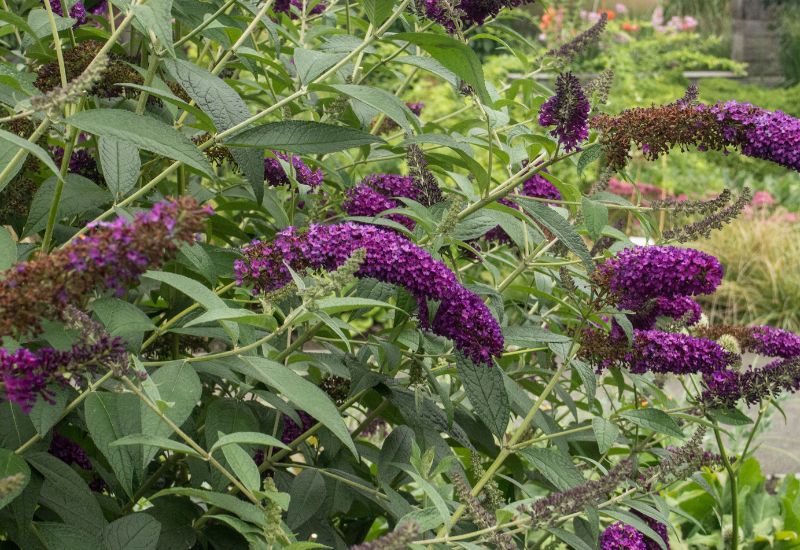
Butterfly bush is so called because it attracts lots of pollinators, and it can really help you achieve that fully natural landscaping style that suits so well hydrangeas. As a companion shrub, in fact, this Asian beauty will offer you long and dense bending panicles made up of literally hundreds of flowers, which will last all the way from mid summer to early fall, or sometimes even beyond.
Hydrangeas often stop blossoming in summer, due to heat, and Buddleia alata can help you keep your floral displays going… It also offers you shades from strong to delicate with white, lavender, blue, lilac, magenta and purple.
All, however have a really sweet fragrance. The arching branches will give you a variation from those of our protagonists, bearing deciduous and the gray green, lance shaped leaves, a little harmonic twist for your garden.
Very easy to grow and sturdy, butterfly bush will grow very well and happily next to your hydrangea; while they love sunny spots, they grow well in dappled, light and partial shade as well.
5. Sweet Fern (Comptonia peregrina)
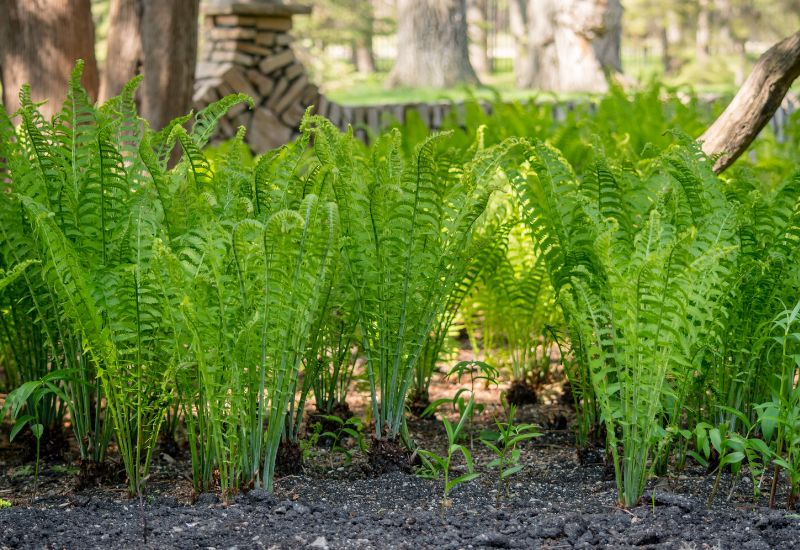
Cold hardy, both Sun and shade loving, and native of North America, sweet fern has the ideal size to look good at the feet of a hydrangea shrub, as a little sister but with a twist – and for this reason, sweet fern will make a good companion.
But it has much more to offer! To start with its foliage is fragrant if you crush it, which will add a dimension to your garden. It forms clumps of fern like fronds with its long and narrow, deeply lobed emerald to deep forest green leaves, about 4 inches long (10 cm).
They are very glossy and decorative lush and dense, which perfectly suits the underbrush and luscious personality of our bush. Look at them at close distance, and you will notice that they look a bit like rattlesnake tails. In late spring and early summer it will also give you greenish yellowish flowers, which are small, actually inconspicuous but they attract lots of butterflies and pollinators to liven up your garden.
And they are followed by brownish burr like capsules that add a small touch of woodland beauty till later in the season. Low maintenance, strong and easy to grow, it will also propagate spontaneously, so it is perfect if you want it for a naturalized area.
Sweet fern will tolerate the same growing conditions of hydrangeas and even much harsher ones; it has a temperate forest appearance and presence that really fits the role of companion shrub for hydrangeas if you want to extoll its woodland look potential.
Tree Companion Plants to Pair with Your Hydrangeas
You can grow hydrangea in the dappled shade of tall trees, and in fact it’s one of the reasons why we love them, but that’s not actual a companion plant. But if you think about some small trees with interesting foliage, you can literally grow them next to our shrubs and achieve a great landscaping effect! Here are the best!
6. Japanese Maple (Acer palmatum)
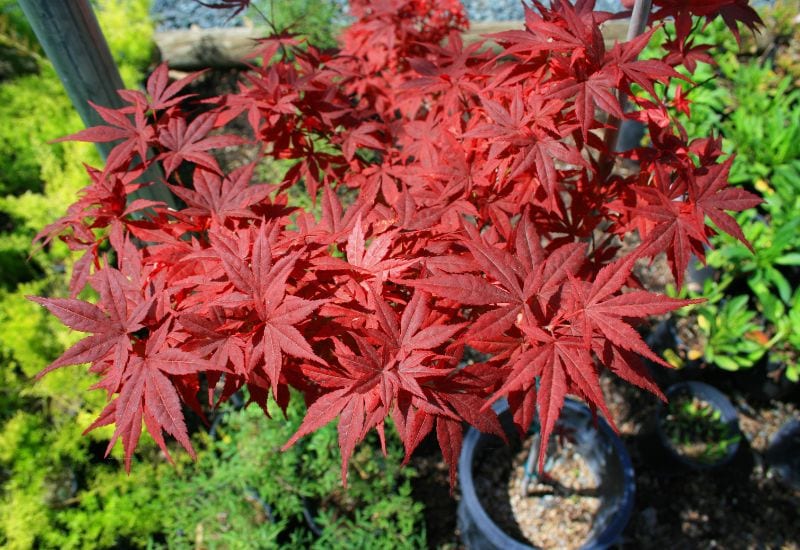
Japanese maple is one of the most decorative small trees you can have in your garden, and it really makes a perfect companion plant for hydrangeas. It has a comparable size, it likes similar growing conditions, and it has lots of beautiful foliage!
And this is really what you need to appreciate to have a great effect! With elegant, finely textured palmate leaves of many colors, like the ruby ‘Chitose Yama’ (winner of the Award of Garden Merit by the Royal Horticultural Society), or the crimson red (in spring) and then deep purple ‘Tamaukeyama’, you can really create a lovely contrast.
Or you could pick up the green of your hydrangea and carry it over to this small tree, with the soft looking ‘Beni-Kawa’. They usually change to drastic shades in fall before falling…
Japanese maples have a very elegant and umbrella like crown, which can really work well with the round habit of hydrangeas, even becoming a visual whole in your landscaping composition. In this case, I would suggest contrasting colors for best effect.
7. Lawson Cypress (Chamaecyparis Lawsoniana)
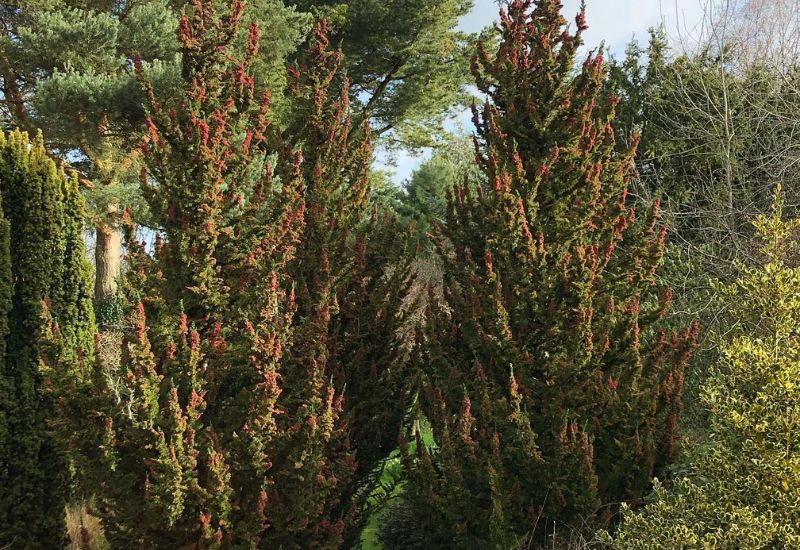
Lawson cypress is a lovely small conifer with a shrubby look, and it can really look good next to your hydrangeas as companion. Columnar, conical or pyramidal in shape and of similar size to our shrub, it will help you give your composition an interesting change. Very dense, the evergreen foliage will also provide structure during the winter months.
And you can also choose between a series of interesting colors. For example, winner of the Award of Garden Merit by the Royal Horticultural Society ‘Pembury Blue’ has vivid aquamarine. Or you could pick the small ‘Minima Aurea’ another receiver of the prize, for its golden tips.
On the other hand, the cylindrical ‘Ellwoodii’ will offer you silver blue for its all year round display. They are small growers, so you may need to buy a big specimen to have a quick effect, or you could just wait.
While it will not contribute to your flower show, and those of your hydrangeas, these two plants really work well together for texture, mixing the broad herbaceous leaves of hydrangea with the feathery and finely textured of Lawson cypress and for shape combinations. It can also slightly acidify the soil over time, and hydrangeas will appreciate it.
Perennial Flower Companions for Stunning Hydrangeas
Perennials are one of the most varied and numerous garden plants ever, and this means that quite a few will match the growing conditions that hydrangea likes. But remember that there are other characteristics to keep in mind, like size and how showy they are. So, here are a few that tick all the boxes.
8. Daylily (Hemerocallis spp.)
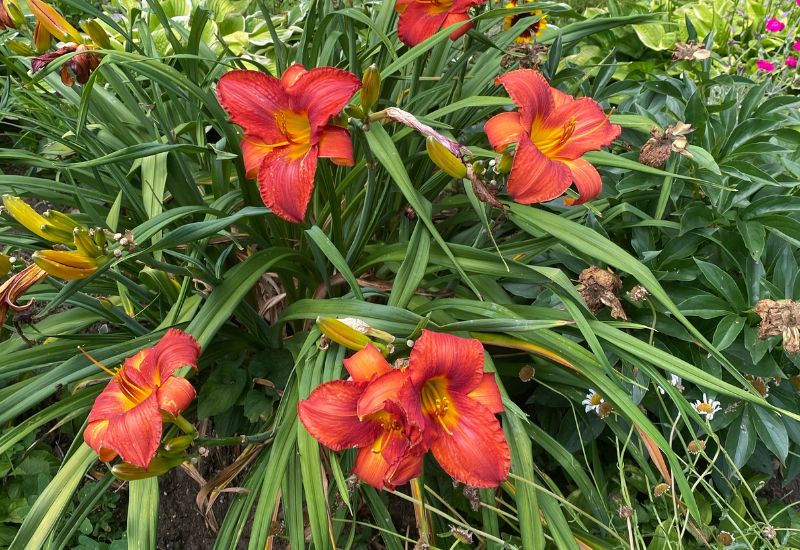
Daylily has it all to be a good companion plant for hydrangeas! Let us start with its super showy lily like flowers; they can be up to 6 inches across (15 cm), and while they only last one day, this perennial really keeps giving new ones every day all through the summer.
The plants literally cover in eye catching blossoms with an impressive color range. You can choose strong shades, like with ‘Baja’, which is scarlet with a saffron center, or the deep purple American Revolution’… Otherwise, softer tonalities are all in its palette… ‘Early Snow’ is white with a sheen of bright rose… ‘Bertie Ferris’ is apricot, ‘Lullaby Baby’ is pure delicate rose, and ‘Omomuki’ is chartreuse…
There is really a cultivar in every color, from white to almost black, excluding blue. The lush long, arching and mid green, smooth looking foliage forms big tufts of freshness, like grass, but more fleshy…
Maybe the main reason to pick daylilies as companion plants for hydrangeas is that our shrub can have a very refined palette, but also strong colors, and our perennial offers you a wide range as well. But remember also that it is super low maintenance and easy to grow. But always generous!
9. Coral Bells (Euchera spp.)
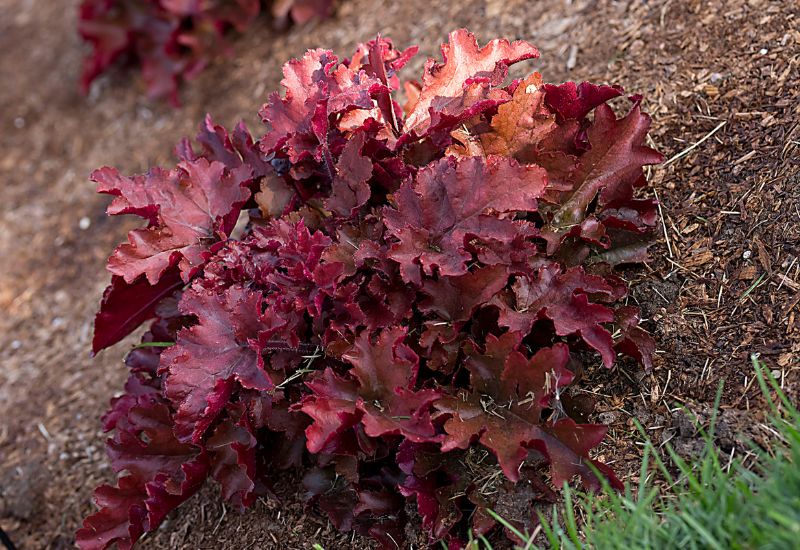
Coral bells is a smaller perennial that will look lovely at the feet of your hydrangea. It offers you lush and broad, lobed foliage that forms very harmonic clumps. And you can pick almost any color… ‘Amber Waves’, for example has golden with orange blushes, ‘Amethyst Mist’ instead will wow you with the depth of plum to burgundy leaves…
But we can go even deeper, with ‘Bella Nocte’ of a purple violet so dark that it is almost black, but ‘Black Taffeta’ with frilly margins and ‘Black Forest Cake’ are even darker! Or you could choose the smooth and glossy ‘Blondie’ and its copper.
If you want the most vibrant red of all, then ‘Cherry Cola’ is the best! In spring and summer, it will also produce long stems that fill with bell shaped flowers which can be white, pink, yellow or red!
Plant coral bells just out of reach of your hydrangea’s branches, and you can frame your shrub with its amazingly colorful foliage and elegant blooms, just like you would do with a lovely painting.
10. Chinese Astilbe (Astilbe chinensis)
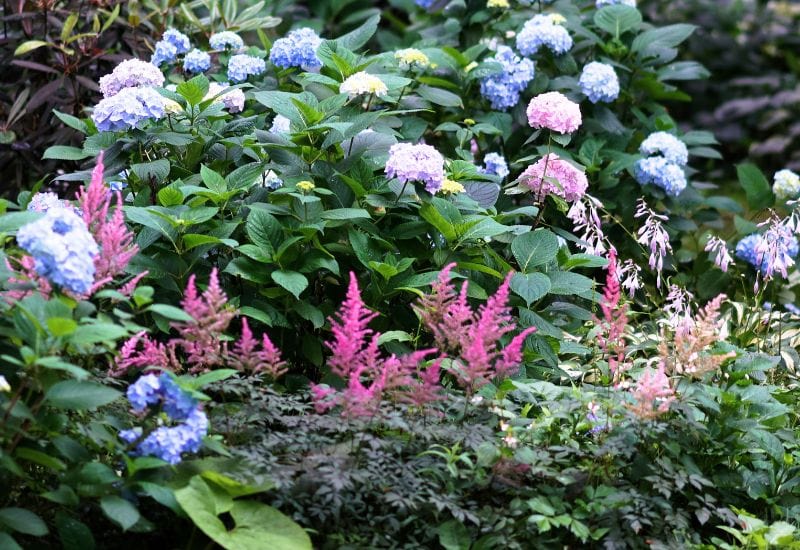
Chinese astilbe is a taller perennial than the common one, and for this reason, it gives you a bigger, more visually impressive effect as a companion to hydrangeas, especially big varieties. Long and showy, feathery plumes of tiny flowers will bloom for months in summer, and they will give you an impressive splash of color, thanks to their density.
They can be white, rose, pink, lilac or magenta, but maybe an exceptional cultivar is ‘Chocolate Cherry’, with cherry red blossoms and chocolate stems, hence the name. The thick mound of fern like, pinnate and serrated leaves that arch underneath this floral display gives you that lush underbrush effect that goes so perfectly well with our shrubs, and they are mid green, sometimes glossy, and at times with reddish blushes and undersides.
Chinese astilbe is another perennial that you can grow next to your hydrangeas making sure that it stays out of reach of its branches. Apart from this precaution, it should cause you no problems or headaches, as it is strong and low maintenance.
11. Foxglove (Digitalis purpurea)

Foxglove is a short lived perennial (sometimes biennial) with a showy but herbaceous and natural look, which can go well with the personality of hydrangeas. What is more, it gives you a vertical accent that you can accost to the round habit of our shrubs for variation and effect.
In fact, the tall spikes with pendulous, funnel shaped flowers are impossible to miss. Often very full, they come in many colors and always with interesting spots in the throat.The blossoms can be white, pink, magenta, mauve and lilac. But if you want an extremely delicate variety, ‘Dalmatian Peach’ has the softest, faintest shade of peach, of course, and bright orange maculation.
Brightening up your summer days for a long time, they are about 2 inches long each, but it is the overall show you are after. The clump of long and broad pointed and spirally arranged leaves, up to 13.8 inches long (35 cm) gives you a sense of continuity with the foliage of hydrangeas, though they have a hirsute surface with many hairs.
Foxglove really helps you achieve the natural and traditional landscaping effect if you grow it next to hydrangeas, especially when in bloom, and if you have a cottage garden, it is a must have!
12. Plantain Lily (Hosta spp.)
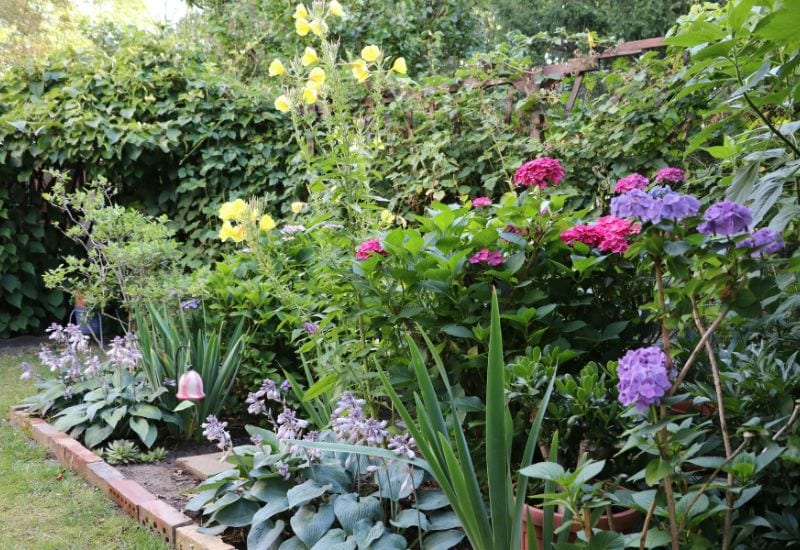
Plantain lilies are great to accompany and enhance the dense foliage of hydrangeas. They are clump forming, with lush, soft looking and heart shaped leaves that match the size of those of our shrub, about 8 inches in length (20 cm).
While they are small, you can use them to lead your eye to your centerpiece, and you can do it with the exceptional coloring of our little perennial. In fact, the foliage can be green, dark or bright, but also blue, aquamarine and chalky. Or you can choose a variegated type, with whites and yellows in it.
If you want some exceptional cultivars, ‘Blue Angel’ has massive leaves, of course dark blue, with a deep texture and they can reach 16 inches long (40 cm), while those of ‘Abiqua Drinking Ground’ are cupped and sculptural. Spikes of elegant bell shaped, flowers will appear in summer and offer you shades of ivory to lilac.
Plantain lilies and hydrangeas love each other; they have matching personalities despite their different sizes; do make sure you do not plant your companion perennial under your shrub, but near them.
13. Blue Star (Amsonia tabernaemontana)
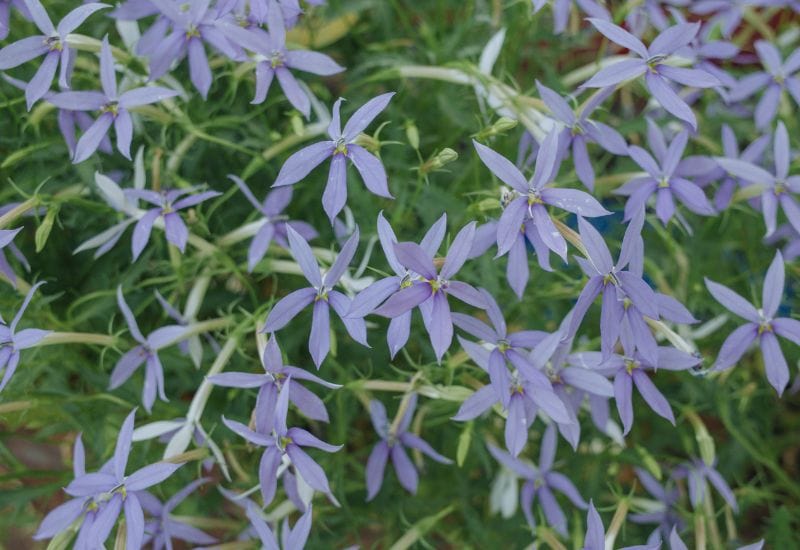
I would like to propose a little known but stunning perennial as a good companion plant for your hydrangea: blue star! It forms basket shaped clumps or sometimes round, fairly large and certainly showy, but temperate and natural looking when in bloom.
The almost black and long stems that carry both foliage and flowers, in fact, will fill with large clusters of small star shaped flowers of a lovely, heavenly sky blue color! And this will happen repeatedly throughout the year, with pauses, attracting lots of butterflies and pollinators each time.
Every wave will last about 4 to 6 weeks and you will get two or three in a year, in spring, summer and fall. But even the buds are interesting, with their dark purple blue tonality… the leaves are pointed, very dark green with a clear and much brighter mid rib.
Grown near your hydrangea, blue star will surprise you over and over again with its vigorous blooms, sometimes compensating for the lack of blossoms on your shrub, sometimes adding to them.
Ornamental Grasses and Ferns As Companion Plants for Hydrangeas
Ferns and ornamental grasses will not give you blooms to accompany your hydrangea shrubs, but… They will definitely frame them well, and they will add and attract attention to the foliage of your shade loving flowering bush. We can see a few varieties that will help you achieve this landscaping effect right now!
14. Hakone Grass (Hakonechloa macra)
Hakone is arguably the best decorative grass to grow as a companion plant to hydrangeas. The reason? Very simple: it matches the growing conditions of our shrub and it has amazingly colorful foliage. This will give you two benefits.
To start with it will help you enhance or increase the palette of your shrub, and secondly, it will add to its lush and fresh look. Blade like and often arching beautifully, the tufts of Hacknechloa macra you can grow at the feet of your flowering bush can be green, but the many cultivars offer amazing variations.
For instance, ‘All Gold’ is so bright that it literally shines in the shade! On the other hand, ‘Aureola’ has stripes of bright green and yellow, while ‘Stripe it Rich’ has gold and white! ‘Nicolas’ has a fiery variegation of oranges, reds and some shay green blushes. Finally, ‘Naomi’ offers you cream, blue and purple in shading combinations!
Low maintenance and very attractive, Hakone grass in all its varieties can frame your hydrangea with a colorful and sometimes literally surprising touch, and, being evergreen, it will provide interest and structure all year round. Finally, you can even grow it literally under your hydrangea!
15. Eastern Hay Scented Fern (Dennstaedtia punctilobula)
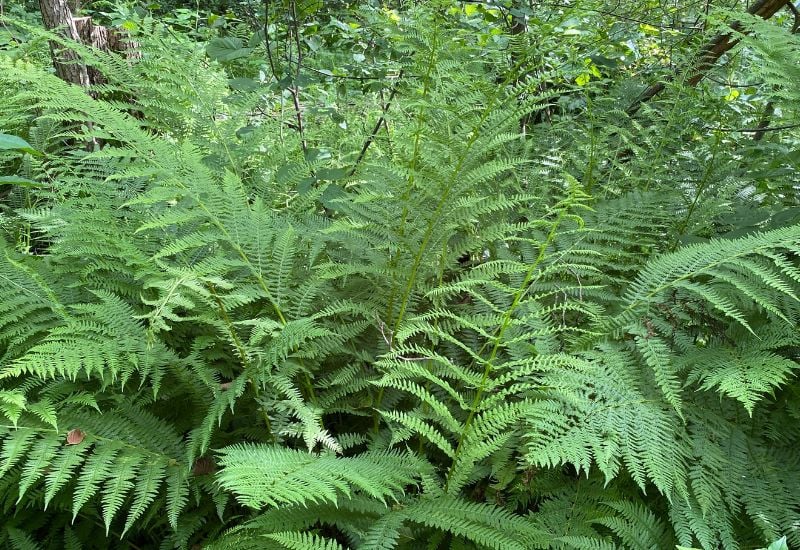
You could choose other cold hardy fern varieties as companion plants for your hydrangea, but eastern hay scented fern has a special touch! To start with it has a strong scent of freshly cut hay, as the name suggests. This will definitely set it apart from other species.
In fact it is dried and used as an aroma… Native of forested areas of North America, it tolerates cold climates and shaded places, like at the feet or even under your flowering shrubs! It also has that underbrush appearance that really suits our bush.
If you already grow your hydrangea under trees, this fern will add yet another bushy layer at ground level… What is more, it forms rosettes of gently curving, bright green fronds. These are bright green and with a very, very fine texture, and they will turn yellow in fall before dying off. But the foliage will start again in spring for a new fresh spectacle!
Easy to grow, eastern hay scented fern will also propagate spontaneously thanks to its rhizomes, which makes it great also as ground cover at the feet of your hydrangea, even in naturalized and woodland areas, coating the soil with its lush foliage and keeping company to your blooming shrubs in the shade!
Lots Of Plants To Keep Company To Your Hydrangea Shrubs…
… And more, because with these shrubs, trees, perennials, decorative grasses and ferns, you can enhance the beauty of your hydrangeas, create colorful ensembles, add texture with their foliage, create beautiful compositions with different shapes and – above all – you can make your flowering bush mingle in with the whole of your garden, as if had always been there!

Written By
Amber Noyes
Amber Noyes was born and raised in a suburban California town, San Mateo. She holds a master’s degree in horticulture from the University of California as well as a BS in Biology from the University of San Francisco. With experience working on an organic farm, water conservation research, farmers’ markets, and plant nursery, she understands what makes plants thrive and how we can better understand the connection between microclimate and plant health. When she’s not on the land, Amber loves informing people of new ideas/things related to gardening, especially organic gardening, houseplants, and growing plants in a small space.

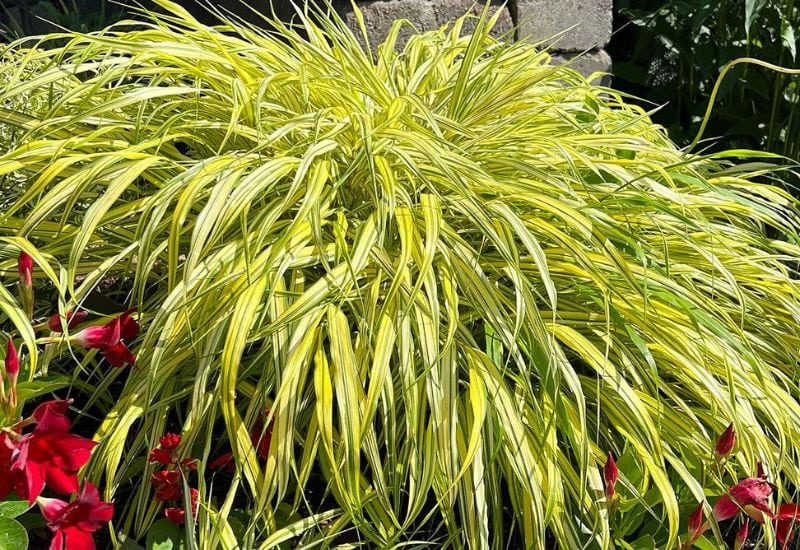
Do you know if any of these are deer resistant? My yard has visitors of up to 3 times a day with up to 14-16 deer. I am between their watering hole and their homes.